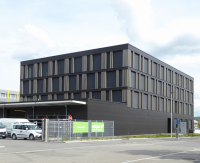Quartz is the second most abundant mineral in the Earth's continental crust, after feldspar. It is composed of a continuous framework of SiO4 silicon-oxygen tetrahedra, with each oxygen atom being shared between two tetrahedra, resulting in the overall formula SiO2. There are many different varieties of quartz, several of which are semi-precious gemstones. In Europe and the Middle East in particular, varieties of quartz have been the most commonly used minerals for making jewellery and hardstone carvings since antiquity. The word 'quartz' is derived from the German 'quarz', which originated in Middle High German 'twarc', itself derived from Slavic languages (cf. Czech 'tvrdý' ('hard'), Polish 'twardy' ('hard'), Russian 'твёрдый' ('hard')), ultimately from Old Church Slavonic 'tvrdъ' ('firm'), and Proto-Slavic '*tvьrdъ'.
Piezoelectricity
Quartz crystals have piezoelectric properties; they develop an electric potential upon the application of mechanical stress. An early use of this property of quartz crystals was in phonograph pickups. One of the most common piezoelectric uses of quartz today is as a crystal oscillator. The quartz clock is a familiar device using the mineral. The resonant frequency of a quartz crystal oscillator is changed by mechanically loading it, and this principle is used for very accurate measurements of very small mass changes in the quartz crystal microbalance and in thin-film thickness monitors.
( from Wikipedia http://en.wikipedia.org/wiki/Quartz)


